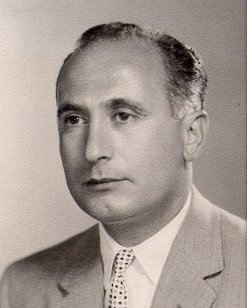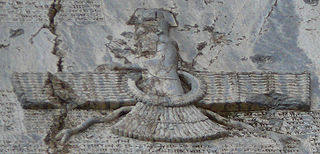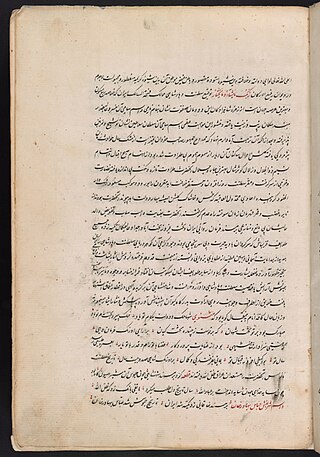The Persians are an Iranian ethnic group who comprise over half of the population of Iran. They share a common cultural system and are native speakers of the Persian language as well as of the languages that are closely related to Persian.

Hormizd III, was the seventeenth king (shah) of the Sasanian Empire, ruling briefly from 457 to 459. He was the son and successor of Yazdegerd II. His reign was marked by the rebellion of his younger brother Peroz I, who with the aid of one of the Seven Great Houses of Iran, the House of Mihran, and the eastern neighbours of the Sasanians, the Hephthalites, had him captured and executed.

Atropatene, also known as Media Atropatene, was an ancient Iranian kingdom established in c. 323 BC by the Persian satrap Atropates. The kingdom, centered in present-day northern Iran, was ruled by Atropates' descendants until the early 1st-century AD, when the Parthian Arsacid dynasty supplanted them. It was conquered by the Sasanians in 226, and turned into a province governed by a marzban ("margrave"). Atropatene was the only Iranian region to remain under Zoroastrian authority from the Achaemenids to the Arab conquest without interruption, aside from being briefly ruled by the Macedonian king Alexander the Great.

Mazdak was a Zoroastrian mobad (priest), Iranian reformer, prophet and religious reformer who gained influence during the reign of the Sasanian emperor Kavadh I. He claimed to be a prophet of Ahura Mazda and instituted social welfare programs.

Ehsan Yarshater was an Iranian historian and linguist who specialized in Iranology. He was the founder and director of the Center for Iranian Studies, and Hagop Kevorkian Professor Emeritus of Iranian Studies at Columbia University.
Iranian Canadians or Persian Canadians are Canadians of Iranian origin. From the 2016 Canadian census, the main communities can be found in Southern Ontario, British Columbia, and Quebec. The vast majority, however, live in northern suburbs of Toronto such as Richmond Hill, Vaughan, Markham, and Thornhill, and in certain municipalities of Vancouver, including North Vancouver, West Vancouver, Burnaby, and Coquitlam. As of 2016 a total of 97,110 Iranians reside in the Greater Toronto Area, 46,255 in the Greater Vancouver Area, and 23,410 in the Greater Montreal Area, with the remainder spread out in the other major cities of Canada, based on the 2016 Canadian Census. These numbers represent the people who stated "Iranian" as their single or joint ethnic origin in the census survey.

In the Western world, Persia was historically the common name used for Iran. On the Nowruz of 1935, Reza Shah officially asked foreign delegates to use the Persian term Iran, the endonym of the country, in formal correspondence. Subsequently, the common adjective for citizens of Iran changed from Persian to Iranian. In 1959, the government of Mohammad Reza Pahlavi, Reza Shah's son, announced that both "Persia" and "Iran" could be used interchangeably, in formal correspondence. However, the issue is still debated (see § Recent debate) among Iranians.

Greater Iran or Greater Persia, also called the Iranosphere or the Persosphere, is an expression that denotes a wide socio-cultural region comprising parts of West Asia, the Caucasus, Central Asia, South Asia, and East Asia —all of which have been impacted, to some degree, by the Iranian peoples and the Iranian languages. It is defined by having been long-ruled by the dynasties of various Iranian empires, under whom the local populaces gradually incorporated some degree of Iranian influence into their cultural and/or linguistic traditions; or alternatively as where a considerable number of Iranians settled to still maintain communities who patronize their respective cultures, geographically corresponding to the areas surrounding the Iranian plateau. It is referred to as the "Iranian Cultural Continent" by Encyclopædia Iranica.

Abdul Qadir Gilani was a Hanbali scholar, preacher, and Sufi leader who was the eponym of the Qadiriyya, one of the oldest Sufi orders.
Iranian Australians or Persian Australians are Australian citizens who are of Iranian ancestry or who hold Iranian citizenship.
The page details the timeline of History of Iran.

The khanates of the Caucasus, also known as the Azerbaijani khanates, Persian khanates, or Iranian khanates, were various administrative units in the South Caucasus governed by a hereditary or appointed ruler under the official rule of Iran. The title of the ruler was khan, which was identical to the Ottoman rank of pasha. Following the assassination of Nader Shah in 1747, internal chaos erupted in Iran, particularly in the South Caucasus, where semi-autonomous khanates emerged as a result of the lack of a centralized government. The khans neither had territorial or religious unity, nor an ethnic/national identity. They were mostly interested in preserving their positions and income.
Religion in Iran has been shaped by multiple religions and sects over the course of the country's history. Zoroastrianism was the main followed religion during the Achaemenid Empire, Parthian Empire, and Sasanian Empire. Another Iranian religion known as Manichaeanism was present in Iran during this period. Jewish and Christian communities thrived, especially in the territories of northwestern, western, and southern Iran—mainly Caucasian Albania, Asoristan, Persian Armenia, and Caucasian Iberia. A significant number of Iranian peoples also adhered to Buddhism in what was then eastern Iran, such as the regions of Bactria and Sogdia.
Iranians in France include immigrants from Iran to France as well as their descendants of Iranian heritage or background. Iranians in France are referred to by hyphenated terms such as French-Iranians or French-Persians.

Iskandar Beg Munshi was an Iranian court scribe and chronicler, who is principally known for his historical book of Tarikh-e Alam-ara-ye Abbasi, which focuses on early Safavid history, especially the reign of Shah Abbas I.

The Pishdadian dynasty is a mythical line of primordial kings featured in Zoroastrian belief and Persian mythology. They are presented in legend as originally rulers of the world but whose realm was eventually limited to Ērānshahr or Greater Iran. Although there are scattered references to them in the Zoroastrian scriptures—the Avesta—and later Pahlavi literature, it is through the 11th-century Iranian national epic, the Shahnameh, that the canonical form of their legends is known. From the 9th century, Muslim writers, notably Tabari, re-told many of the Pishdadian legends in prose histories and other works. The Pishdadian kings and the stories relating to them have no basis in historical fact, however.
Swedish Iranians or Swedish Persians consist of people of Iranian nationality who have settled in Sweden, as well as Swedish residents and citizens of Iranian heritage. As of 2019, there were 80,136 residents of Sweden born in Iran, as well as 40,883 born in Sweden with at least one Iranian-born parent.

The Azadan were a class of Iranian nobles. They are probably identical to the eleutheroi mentioned in Greek sources to refer to a group of Parthian nobles. According to the 1st-century Romano-Jewish historian Josephus, the Parthian army led by prince Pacorus I during the invasion of Judea consisted of members of the eleutheroi. The Kingdom of Armenia adopted the same hierarchy as that of the Parthians, which included the azadan class, which was used to label the Armenian middle and lower nobility. The name of the Georgian nobility, Aznauri, also corresponded to that of azadan. A class of azadan are also attested in Sogdia, an Iranian civilization located in Central Asia.

Adurbadagan was a Sasanian province located in northern Iran, almost corresponded to the present-day Iranian Azerbaijan. Governed by a marzban ("margrave"), it functioned as an important frontier region against the neighbouring country of Armenia.

Sasanian Iberia was the period the Kingdom of Iberia was under the suzerainty of the Sasanian Empire. The period includes when it was ruled by Marzbans (governors) appointed by the Sasanid Iranian king, and later through the Principality of Iberia.












